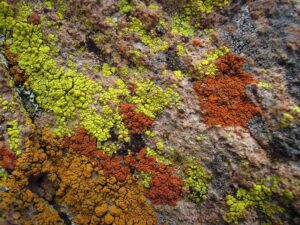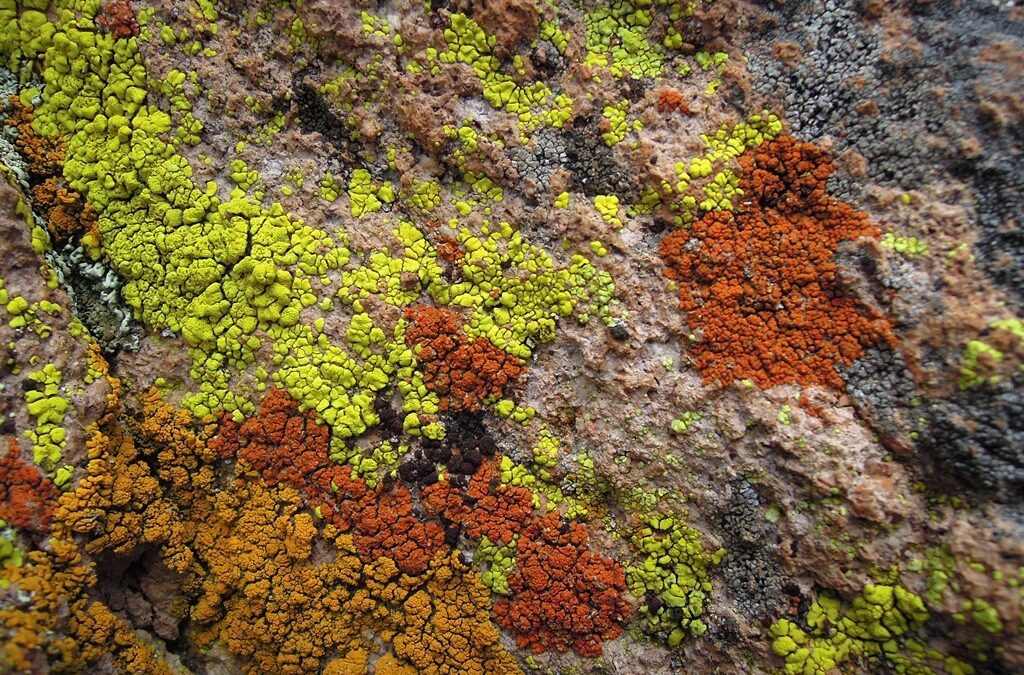
Lichen is some of nature’s artwork. Photo courtesy of Jerry Walters, Volunteer, Friends of the Forest.
What is that fuzzy or scaly stuff that grows on rocks, trees, and even soil in our area? It is probably a lichen.
Since March of 2015, Friends of the Forest member, Garry Neil, with the assistance of Janie Agyagos, Wildlife Biologist for the US Forest Service, have been working on a survey of lichen species found in the Coconino National Forest. The Forest Service is particularly interested to learn whether there are rare or endangered species in our area. Discovering and documenting the majority of the lichens species growing in the Red Rock area will take some time, since many are remote from area trail systems. So far, Neil along with ten FOF volunteers have discovered a small number of lichen species that have never been observed and documented in this area. Altogether, since 2015, 298 species have been collected, identified, cataloged, and then stored at the Lichen Herbarium at Arizona State University. There, the vailidation of their identity is conducted by Dr. Frank Bungartz, curator of the ASU Lichen Herbarium and entered into a national data base, the Consortium of North American Herbaria.
Neil has an academic background in lichen physiology and ecology. Retirement has provided an opportunity for him to delve into lichen taxonomy and identification. Neil says, “Lichens are generally ignored by the public, with greater interest focused on flowering plants and trees. However, I believe that once you start to focus on lichens many will find that they are fascinating organisms.”
So what exactly is a lichen? Quite an amazing organism actually. Lichens are a symbiotic organism composed of a fungus and an algae or cyanobacterium (in the past called blue-green algae) or both. Basically the algae and cyanobacterium provide the carbohydrates through photosynthesis to the fungus and the fungus in turn provides the capturing of moisture and mineral nutrients, protection from dehydration and too much light to the algae/cyanobacterium. Those with cyanobacterium also have the ability to fix nitrogen which makes it available for higher forms of vegetation. Even with this cohabitation of two or three organisms, they have been placed in the kingdom Fungi. Lichen can be found growing in almost every microhabitat on this planet.
There are four growth forms of lichens – foliose, crustose, fruticose, and squamulose. Foliose lichens are usually leafy looking and have two distinguishable sides. Crustose lichens, as the name implies, are crusty and are usually firmly attached to their substrate (e.g., rocks, tree bark, soil, and even metal). Fruticose lichens can be pendant and hair-like and shrubby. Many fruticose have round branches with a central core or hollow in the middle. Other fruticose may have flat branches which are the same on either side. Squamulose are small lichens that have a scale-like appearance.
Beyond these general classifications, lichens can be very difficult to identify since characteristics of species may vary only minutely. Chemical analysis is usually required to confirm identifications.
So why might we be appreciative that lichens abound in our area? “Lichens are major partners in biological soil crusts”, says Neil, “and are found living on the surface of the crust with mosses, liverworts, fungi, algae, and bacteria. They, along with the other inhabitants, play a major role in enriching the soil, such as in the top layer of soil crust in dryland areas that is commonly found in the Red Rock District.” The process of nitrogen fixation occurs in cyanolichens that grow on soil (nitrogen fixing takes atmospheric nitrogen, converts it, and makes it available in the soil to non-nitrogen fixing plants which benefit from it). Lichens also contribute vertebrate food, nesting material, and shelter for wildlife. These are good reasons to not “bust the crust” when out in the Coconino National Forest.
And there are still more reasons for liking lichens. Lichens are excellent indicators of pollution gasses, with certain species reacting negatively to the presence of pollutants. Additionally, in the commercial arena, lichens have shown to be of value in the making of dyes, perfumes, and pharmaceuticals.
Interested in learning more about “lichen hunting” and other volunteer opportunities in the Red Rock Ranger District? Visit Friends of the Forest at www.friendsoftheforestsedona.org
Serving Sedona, written this week by Garry Neil and Jennifer Young, Friends of the Forest, appears Wednesday in the Sedona Red Rock News.
